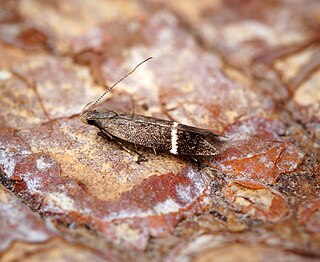
Aproaerema is a genus of moths in the family Gelechiidae.

Syncopacma is a genus of moths in the family Gelechiidae.
Leucoptera genistae is a moth in the family Lyonetiidae. It is found in France, Italy, Austria, Hungary and Bulgaria.

Orobanche rapum-genistae, the greater broomrape, is a plant species in the genus Orobanche. It is a parasitic plant, native to Europe, growing on the roots of plants in the bean family, usually common broom or European gorse.

Coleophora genistae is a moth of the family Coleophoridae. It is found from Sweden to the Iberian Peninsula, Sardinia, Italy and Greece and from Great Britain to Romania. It is also known from Turkey.

Syncopacma coronillella is a moth of the family Gelechiidae. It is found in most of Europe, except Ireland, Great Britain, Fennoscandia, the Baltic region, the Benelux, Portugal and part of the Balkan Peninsula.

Zygaena cynarae is a species of moth in the Zygaenidae family. It is found from France east to Russia.

Syncopacma thaumalea is a moth of the family Gelechiidae. It is found on the Canary Islands and in North Africa.
Syncopacma steppicolella is a moth of the family Gelechiidae. It is found in Russia. The habitat consists of dry steppe slopes with diversified flora.
Syncopacma polychromella is a moth of the family Gelechiidae, it was described by Hans Rebel in 1902.
Syncopacma albifrontella is a moth of the family Gelechiidae. It was described by Hermann von Heinemann in 1870. It is found in Great Britain, France, Germany, Austria, Switzerland, Italy, the Czech Republic, Slovakia, Hungary, Romania, Latvia, Lithuania, Ukraine and Russia.
Syncopacma captivella is a moth of the family Gelechiidae. It was described by Gottlieb August Wilhelm Herrich-Schäffer in 1854. It is found in Portugal, Spain, France, Belgium, the Netherlands, Switzerland, Germany, Italy, Hungary, Poland, the Czech Republic, Croatia and Romania.
Syncopacma cincticulella is a moth of the family Gelechiidae. It was described by Charles Théophile Bruand d'Uzelle in 1851. It is found in Asia Minor and southern and south-eastern Europe, where it has been recorded from Spain, France, Germany, Austria, Switzerland, Italy, the Czech Republic, Slovakia, Hungary, Romania, Poland, Ukraine and Russia.
Syncopacma incognitana is a moth of the family Gelechiidae. It was described by László Anthony Gozmány in 1957. It is found in Germany, Austria, Romania, Ukraine and Russia.
Syncopacma linella is a moth of the family Gelechiidae. It was described by Pierre Chrétien in 1904. It is found in France, Austria, Slovakia, Hungary, Romania and Ukraine.

Syncopacma ochrofasciella is a moth of the family Gelechiidae. It was described by Toll in 1936. It is found in the Russian Far East, China (Jilin) and Europe, where it has been recorded from Germany, Poland, Austria, the Czech Republic, Slovakia, Hungary, Romania, Latvia, Ukraine and Russia.
Syncopacma patruella is a moth of the family Gelechiidae. It was described by Josef Johann Mann in 1857. It is found in Asia Minor and Europe, where it has been recorded from Portugal, Spain, France, Germany, Switzerland, Austria, Italy, Slovakia, Croatia, Romania, Bulgaria, Hungary, former Yugoslavia, North Macedonia, Greece and Ukraine, as well as on Corsica and Sicily.

Syncopacma vinella, the Brighton sober, is a moth of the family Gelechiidae. It was described by Bankes in 1898. It is found in Europe, where it has been recorded from Denmark to Hungary, and from Great Britain to Slovakia.
Syncopacma adversa is a moth of the family Gelechiidae. It was described by Annette Frances Braun in 1930. It is found in North America, where it has been recorded from California, Illinois, Kentucky, Ohio and West Virginia.

Aproaerema palpilineella is a moth of the family Gelechiidae. It was described by Vactor Tousey Chambers in 1875. It is found in North America, where it has been recorded from Georgia, Illinois, Indiana, Kansas, Kentucky, Louisiana, Maine, Mississippi, Ohio, Oklahoma, Ontario, Quebec, Tennessee and Texas.








